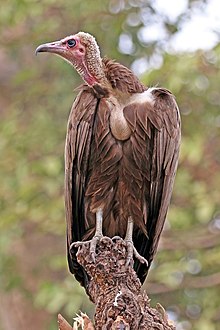| Hooded vulture | |
|---|---|

| |
| in Gambia | |
| Scientific classification | |
| Domain: | Eukaryota |
| Kingdom: | Animalia |
| Phylum: | Chordata |
| Class: | Aves |
| Order: | Accipitriformes |
| Family: | Accipitridae |
| Genus: | Necrosyrtes Gloger, 1841 |
| Species: | N. monachus
|
| Binomial name | |
| Necrosyrtes monachus (Temminck, 1823)
| |
| Synonyms | |
|
Neophron monachus (Temminck, 1823) | |
The hooded vulture (Necrosyrtes monachus) is an Old World vulture in the order Accipitriformes, which also includes eagles, kites, buzzards and hawks. It is the only member of the genus Necrosyrtes, which is sister to the larger Gyps genus, both of which are a part of the Aegypiinae subfamily of Old World vultures.[2][3] It is native to sub-Saharan Africa, where it has a widespread distribution with populations in southern, East and West Africa.[4][5] It is a scruffy-looking, small vulture with dark brown plumage, a long thin bill, bare crown, face and fore-neck, and a downy nape and hind-neck. Its face is usually a light red colour. It typically scavenges on carcasses of wildlife and domestic animals. Although it remains a common species with a stable population in the lower region of Casamance, some areas of The Gambia, and Guinea-Bissau, other regions such as Dakar, Senegal, show more than 85% losses in population over the last 50 years.[5][6] Threats include poisoning, hunting, loss of habitat and collisions with electricity infrastructure, and the International Union for Conservation of Nature has rated its conservation status as "critically endangered" in their latest assessment (2022).[6] The highest current regional density of hooded vultures is in the western region of The Gambia.[7]
- ^ BirdLife International (2017) [amended version of 2017 assessment]. "Necrosyrtes monachus". IUCN Red List of Threatened Species. 2017: e.T22695185A118599398. doi:10.2305/IUCN.UK.2017-3.RLTS.T22695185A118599398.en. Retrieved 20 February 2022.
- ^ Lerner, Heather R.L.; Mindell, David P. (2005). "Phylogeny of eagles, Old World vultures, and other Accipitridae based on nuclear and mitochondrial DNA". Molecular Phylogenetics and Evolution. 37 (2): 327–346. doi:10.1016/j.ympev.2005.04.010. PMID 15925523.
- ^ Catanach, T.A.; Halley, M.R.; Pirro, S. (2024). "Enigmas no longer: using ultraconserved elements to place several unusual hawk taxa and address the non-monophyly of the genus Accipiter (Accipitriformes: Accipitridae)". Biological Journal of the Linnean Society: blae028. doi:10.1093/biolinnean/blae028.
- ^ Reading, Richard P.; Bradley, James; Hancock, Peter; Garbett, Rebecca; Selebatso, Moses; Maude, Glyn (2019-01-02). "Home-range size and movement patterns of Hooded Vultures Necrosyrtes monachus in southern Africa". Ostrich. 90 (1): 73–77. doi:10.2989/00306525.2018.1537314. ISSN 0030-6525. S2CID 92021847.
- ^ a b Wim C. Mullié ... (2017), "The decline of an urban Hooded Vulture Necrosyrtes monachus population in Dakar, Senegal, over 50 years", Ostrich, 88 (2): 131–138, doi:10.2989/00306525.2017.1333538, S2CID 90555471
- ^ a b "The IUCN Redlist of Threatened Species: Hooded vulture". IUCN Red List of Threatened Species. Retrieved 29 June 2019.
- ^ Jallow, M., Barlow, C., Sanyang, L... (2016). "High population density of the Critically Endangered Hooded Vulture Necrosyrtes monachus in Western Region, The Gambia, confirmed by road surveys in 2013 and 2015". Malimbus. 38: 23–28 – via ResearchGate.
{{cite journal}}: CS1 maint: multiple names: authors list (link)
